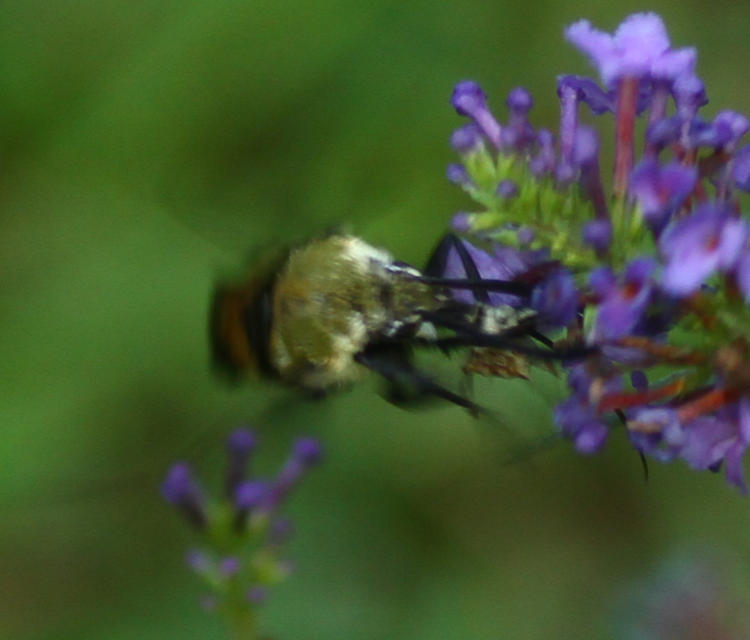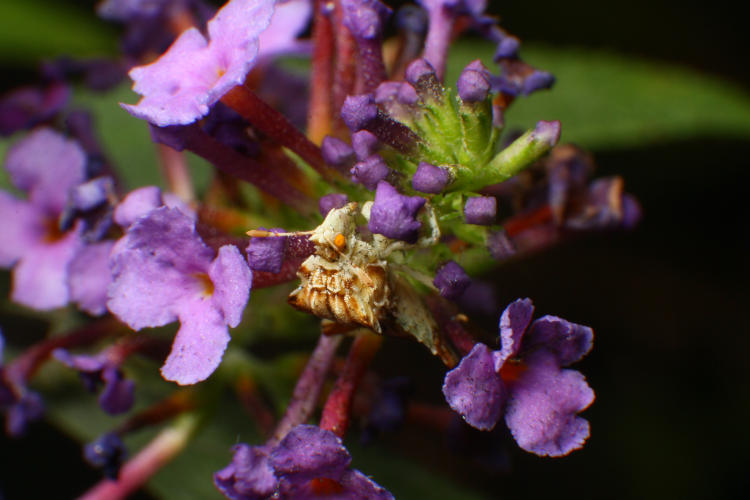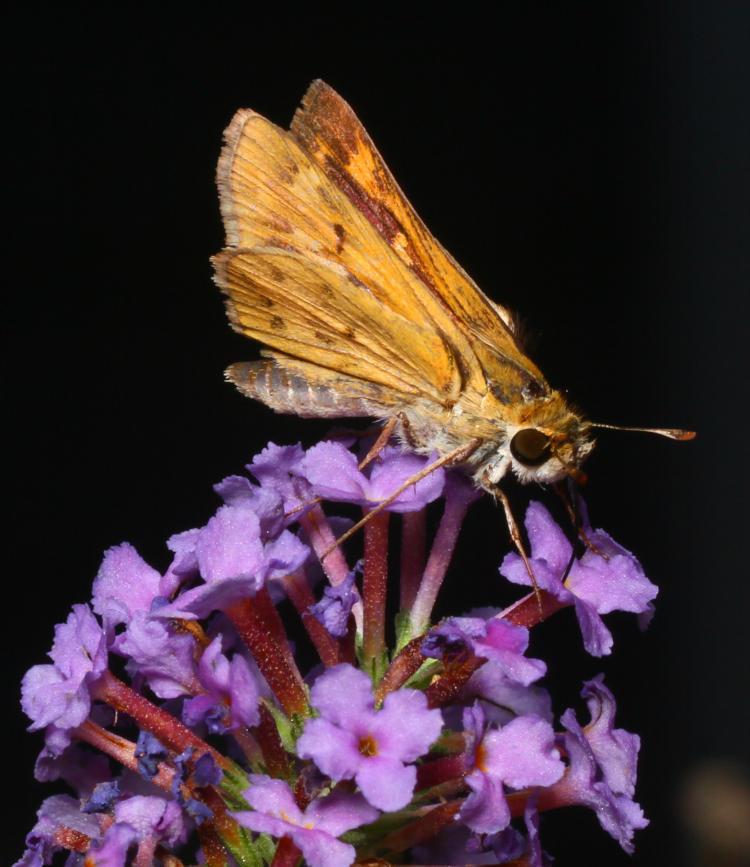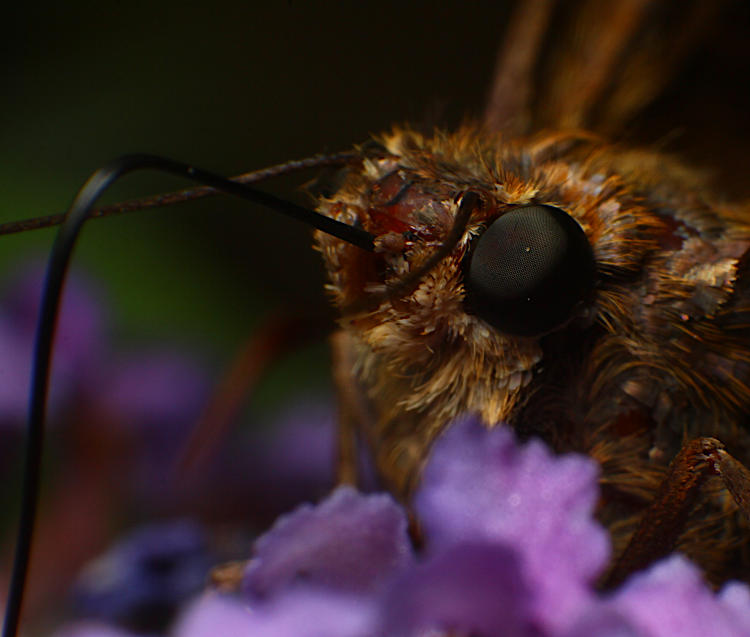I glanced out front just a short while ago and saw one of the Hemaris moths visiting one of the butterfly bushes, and quickly got my camera. The Hemaris species (there are two locally) are better known as the ones that mimic either a hummingbird or a bumblebee, and as such often garner my attention. It was still visiting the bush when I returned, but this may have been due to a little help, since it was thrashing around on one flower cluster, bouncing it around significantly, and this was odd because they don’t alight on the flowers and often only brush them gently. I had the chance for one shot before it freed itself and flew off quickly.

This is the full frame, and normally would be discarded, but it actually held some detail I hadn’t suspected that I’d captured:

You’re seeing the moth from the top/front, close enough to know from the black legs that this is a snowberry clearwing (Hemaris diffinis,) but the tan and brown discolorations seen between its forelegs are actually a jagged ambush bug, lurking within the butterfly bush blossoms. This gives a decent hint of the size disparity, but we’ll have some better illustrations. Suffice to say that this was much bigger prey than I ever thought an ambush bug would tackle, and it held on bravely through at least a few seconds of the moth struggling fiercely to get free.
I sat down to do some detailed photos, and to see if the clearwing moth would return, but this let me do some scale comparisons.

This is likely an eastern carpenter bee (Xylocopa virginica) visiting the same bush, which was immensely popular with the carpenter bees and several species of butterflies this afternoon. This is slightly larger than the snowberry clearwing that was visiting, but average for “bumblebees,” about the size of the top joint of your thumb. And now a frame taken at the same magnification:

Get the size disparity now? This guy really didn’t stand a chance trying to take down a clearwing, but it’s likely that they don’t, or can’t, make such distinctions and simply grab whatever comes near – credit that it held on for a noticeable length of time. And yes, we can get closer still.

Obviously we’re pretty damn close here, still in situ on the butterfly bush – the nice thing about jagged ambush bugs (genus Phymata) is that they hold still and let you lean in as close as you like, only occasionally sidling into deeper cover, and this allows a great view of their gnarly appearance if you can manage the magnification. This one still sports the dislodged scales from the struggle with the clearwing. Even though this is an adult, I can’t offer a specific identification because a) there are 21 species in the US, and b) identification relies on paragraphs like this (from BugGuide.net):
In the eastern states, the lack of an ultraconnexivum on the fourth segment and the large size (7-12 mm) leave only P. americana, P. fasciata, and P. pennsylvanica. From the latter two, the undilated margin will separate P. americana.
I don’t even know what an ultraconnexivum is and I’m not looking it up – seems like a good way to get on an FBI watch list.
But while out there, I did a few other portraits.

This is possibly a fiery skipper (Hylephila phyleus,) but I’m not utterly confident in that, and this was the only good image I got of it. It’s a small butterfly anyway, yet still too big for the ambush bug.
All of these were taken on a bright sunny afternoon, by the way, but we’re relying on the macro flash rig right now, f16 at 1/200 second, so the background drops into darkness. I need to start experimenting with additional background lighting…

I’m a lot more confident that this is a silver-spotted skipper (Epargyreus clarus,) about twice the size of the fiery and quite common around here. It was enthusiastically sampling every blossom on the clusters that it landed on, and since I was already in position, I could wait for it to come around closer.

I can’t compare this to the ambush bug because the magnification was different and I cropped this anyway, but you can make out some scales there so you get an idea anyway. In fact, there are scales missing from the face and it may have already had an encounter with some similar predator. It actually attempted to visit the same flower cluster as the ambush bug, right in front of me, but quickly abandoned it as I was switching to video; the ambush bug appeared to be in a new position afterward and quite likely had made a grab for the skipper. It made me ponder the life of such ambush predators, because they simply wait on a particular flower for something to visit, and I’ve done enough lurking myself: waiting for something to visit this specific flower can take ages, especially when this single bush (among three in the immediate vicinity) had dozens of flower clusters on it. And what’s their success rate, anyway? it was 0 for 2 just as I was watching.
One last, while we’re talking about ambush predators.

One thing about butterfly bushes: their flowers are always about the same size, 7-8mm in width, which means that this guy at full leg spread is about 4, or a body length just surpassing 2mm. Since I can just make out the white band across the face, I’m hazarding that this is a white-banded crab spider (Misumenoides formosipes,) very common around here, especially on the butterfly bushes – another sat in deeper cover on the exact same cluster. Not really sure what this could take down – certainly not the routine visitors to the bushes, like above – but they seem to be successful because I’ve seen them getting bigger. Send me, oh, twenty bucks and I’ll stake one out, see what happens. Might even get some video of it.




















































